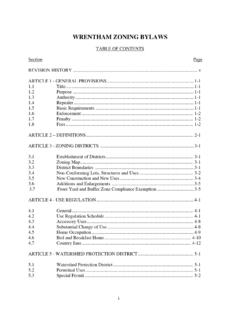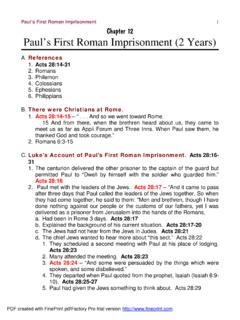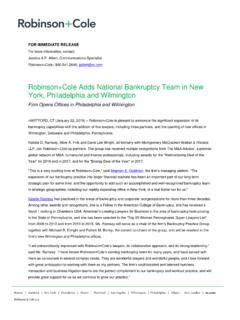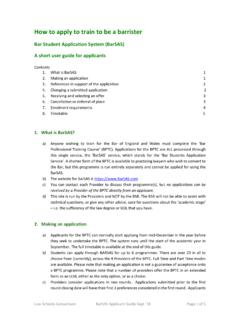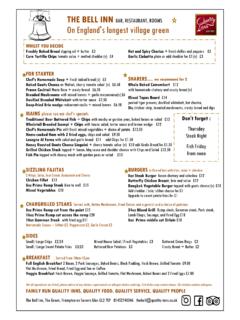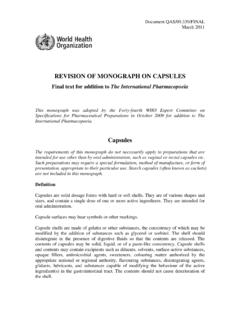Transcription of Playing the game - Funforge
1 1 BDEA2345678 FObject of the gameThe players are travelers in Japan in days of old. They will follow the prestigious Tokaido and try to make this journey as rich an expe-rience as possible. To do this, they will pass through magnificent countryside, taste delicious culinary specialties, purchase souvenirs, benefit from the virtues of hot springs, and have unforgettable the game board on a flat the Achievement cards and place them face up next to the the Meal cards (red back) and make a face-down the Souvenir cards (brown back) and make a face-down the Encounter cards (purple back) and make a face-down the Hot spring cards (light blue back) and make a face-down the Panorama cards by type (Sea, Mountain, Paddy) and by value (placing the 1 above the 2 above the ).
2 Place the 7 resulting piles on their corresponding locations on the the coins next to the board as a player selects a Traveler piece and the correspondingly colored marker and color token (bag). Place the marker on square 0 of the path that records Journey player then takes 2 Tra-veler tiles at random, chooses one and places it face up on the table before player then places his color token (bag) in the hole of his Traveler tile. Place all unchosen and unused tiles in the box out of player receives coins equal to the number in the upper right corner of his chosen tile; this constitutes his bank at the start of the journey. Finally, randomly place all of the Traveler pieces in a line at the 1st inn (Kyoto). Playing the gameIn Tokaido, the player whose Traveler is farthest behind on the road (with respect to the destination) is the player who takes the next player must move his Traveler forward that is, toward Edo to the open space of his choice, freely passing over one or more open spaces, if he he has moved his Traveler, the player receives the benefit corresponding to this type of space.
3 (The spaces are detailed on this page and the next page of these rules.)In most cases, after a Traveler has moved, another Traveler is then last on the road, and it becomes that player s the last Traveler may still be last after moving, in which case he goes again / double spacesSome of the spaces on the board are doubled. When a traveler lands on a double space, he must occupy the space located on the road if it is free; a Tra-veler who arrives after him must occupy the second spaces are used only in games with 4 or 5 players. When Playing with 2 or 3 players, the second space the one off the road cannot be of the spacesEach move leaves a traveler on one of the 8 types of spaces or one of the Inn spaces. In the descriptions below, a collection refers to all of the cards acquired (and placed face up) by a player during a : Travelers immediately score all points earned during the jou r ney.
4 VillageThe player draws the first 3 Souvenir cards from the pile and places them face up in front of him. He can then purchase one or more of these cards by paying the price indicated on each then places any unpurchased cards face down on the bottom of the pile. Each Souvenir is different, and each belongs to one of 4 types: small objects, clothing, art, and food & score the maximum number of points, players need to collect Souvenirs of each type. (Note that you can purchase and score for Souvenirs of any type.) As you purchase Souvenir cards, group them into sets in front of you; each set can contain only one Souvenir of each type. The first Souvenir in a set, no matter which type it is, is worth 1 point. The second Souvenir in a set, which must be of a different type than the first, is worth 3 points.
5 The third Souvenir in a set, which must be of a different type than the first two, is worth 5 points. The fourth Souvenir in a set, which must be of a different type than the first three, is worth 7 : 1 Game board 5 Traveler pieces 5 Travel point markers 5 Player color tokens (bags) 5 0 Coins 10 Traveler tiles 12 Hot Spring cards 6 0 Panorama cards 25 Meal cards 24 Souvenir cards 14 Encounter cards 7 Achievement cards 1 BEDACC2345678 The Green traveler is farthest behind on the road, so he spaceSingle spaceThe Purple traveler is farther behind than the Green traveler, therefore he of travelWay of travel The Green traveler moves (arrow). It s now the Purple traveler s turn. If the Green traveler had moved and was still behind the Purple traveler, he would have to go of travelSouvenirs cost 1, 2 or 3 coins.
6 They are worth 1, 3, 5 or 7 points depending on the actual Souvenirs in a player s player earns these points at the time that he adds these cards to his collection. (Examples of souvenir collecting and the points earned are given below.)Note: A traveler must have at least 1 coin to stop in a Village, but he is not required to purchase any few examples of souvenir collecting: Fa r mThe player takes 3 coins from the reserve and adds them to his is no limit to the number of coins a player can accumulate. PanoramaPanoramas are made of 3, 4 or 5 a player stops on a Panorama Station, if he doesn t yet have any Panorama cards of this type, he takes a Panorama card of value 1 . Otherwise, he takes the next number in ascending immediately scores a number of points equal to the value of the card (1, 2, 3, 4 or 5 depending on the panorama).
7 Note: Each traveler can create only a single panorama of each type; a traveler who completes a panorama can no longer stop on the spaces corresponding to that type (Sea, Mountain, or Pad-dy). Hot SpringThe player takes a Hot Spring card from the pile and adds it to his cards are worth 2 or 3 points. Te m p l eThe player donates 1, 2, or 3 coins to the temple, placing them on the Temple section of the board in the area corresponding to his color. The player immediately scores 1 point for each donated : A traveler who stops on a Temple space must donate at least 1 coin as an offering and cannot donate more than 3 coins. EncountersThe player reveals the top card of the Encounter pile and applies the effect. These effects are listed below. After carrying out an effect, the player adds the card to his (Traveling merchant)The player draws the top Souvenir card from the pile and adds it to his collection.
8 He scores 1, 3, 5, or 7 points depending on which Souve-nirs he already (Guide)If the player has not yet started the depicted panorama, he takes a value 1 card of the appropriate type. If he has started it, he takes the next number in ascending order. If he s completed it, he can start or add to another panorama of his choice. He scores points for the Panorama card as player immediately scores 3 (Noble)The player immediately takes 3 coins from the reserve that he adds to his (Shinto priest )The player immediately takes 1 coin from the bank and places it as an offering in the Temple in the area corresponding to his color. He scores 1 point for this donation. InnsThe Inns are special spaces, and all Travelers must stop at each Inns are the places where players can buy Meal cards.
9 Meal cards cost 1, 2 or 3 coins and all give 6 victory at an innThe Inns, mandatory stopovers for all tra-velers, are places to enjoy a well-earned meal and sample local culinary traveler is obliged to stop at each of the 4 Inns on the way to Edo, so naturally the Inn spaces can hold all of the travelers at the same time. These Inn spaces are on the board in order that players arrive at an Inn is important. The first traveler occupies the space nearest the road, and later travelers form a line after the first traveler arrives at an Inn, he draws as many Meal cards as there are players, plus 1. (For example, in a game with 3 players, he draws 4 cards.)He looks at these cards without showing them to other players. He can then purchase one Meal card of his choice by paying the price (1, 2, or 3 coins) marked on the adds this card, face up, to his collection and places the remaining cards next to the board, face Meal card is worth 6 points, and a player scores these points at the time that he adds this card to his then must wait for the other travelers to arrive at the Inn.
10 Upon arrival, each traveler can (possibly) purchase one of the remaining Meal first traveler to arrive at the Inn therefore has more choice than the last!Important : A traveler cannot taste the same culinary specialty twice during his journey. A traveler can never purchase more than one Meal card per Inn. A traveler is never obliged to purchase a Meal :In a game with four players, the first traveler arrives at the Inn; he draws 5 Meal cards (4 players + 1) and chooses his Meal from among these 5 second traveler arrives at the Inn; he chooses his Meal from among the 4 remaining third traveler arrives at the Inn; he d like to choose a Meal from among the 3 remaining cards, but he doesn t have enough money to pay!Alas, he cannot take a Meal card and goes hungry at this fourth traveler arrives at the Inn with 3 Meal cards from which to choose as the previous traveler did not purchase a purchases one, then places the remaining cards at the bottom of the the journeyOnce all travelers have arrived at the Inn and had a chance to taste the local cuisine, the journey can continue: Place unpurchased Meal cards on the bottom of the appro-priate pile.
